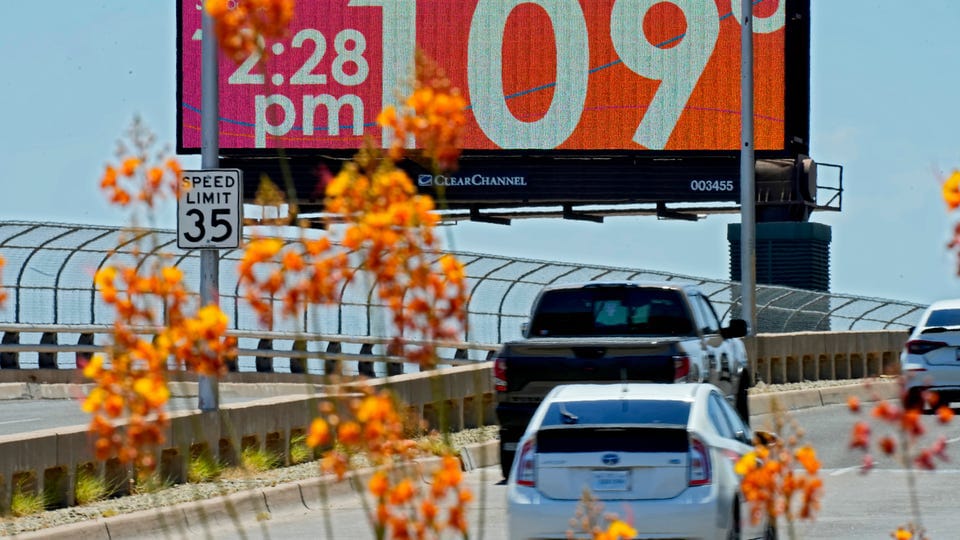Get ready for scorching temperatures as a record-breaking heatwave expands from the West to the Southwest and Gulf Coast states and it has been forecasted that there will be high temperatures, tropical storm updates, heavy rainfall warnings, and the impact of Canadian wildfires on air quality.
Extreme Heatwave Sweeps Through Southwest and Gulf Coast
Prepare to endure scorching temperatures as the relentless heatwave that has been plaguing the West now extends its reach to the Southwest and Gulf Coast states.
The National Weather Service (NWS) has issued forecasts predicting record-breaking temperatures in various regions. Brace yourself for the heat onslaught in the Four Corners states, spanning from Texas to the Lower Mississippi Valley and even South Florida.
Unyielding Heat In The Desert Southwest And Texas
The desert Southwest and Texas are expected to face relentless heat in the coming days. Daytime temperatures will consistently soar into the triple digits, subjecting the region to extreme heat conditions.
Meanwhile, the Gulf Coast and mid-South regions can anticipate temperatures in the mid-to-upper 90s. When combined with the suffocating humidity, the heat index is projected to skyrocket to a staggering 105-115, making it crucial to take precautions and stay cool during this blistering period.
The NWS provides vital insights into the temperature trends and weather patterns affecting these areas.
Northeast and Mid-Atlantic Sizzle Amidst Hot and Humid Conditions
Despite a recent weak cold front passage, the Northeast and mid-Atlantic regions will continue to experience scorching temperatures and oppressive humidity until Tuesday.
It is essential to stay hydrated and seek shade or air-conditioned environments to beat the sweltering heat.
The NWS provides detailed updates on the prevailing weather conditions and precautions to take during this extended heatwave.
Midwest And Great Lakes Expect Cooler Temperatures
Parts of the Midwest and areas near the Great Lakes will be treated to a temporary respite from the scorching heat. Cooler-than-normal temperatures are expected, with highs in the comfortable 70s forecasted for some areas of the Upper Midwest on Tuesday.
Stay informed about the latest weather forecasts and enjoy the relief from the blistering heat in these regions.
Tropical Storm Calvin Approaches Hawai’i
Tropical Storm Calvin, although downgraded from a hurricane, still poses potential risks as it nears the island of Hawai’i.
The NWS closely monitors its trajectory and provides updates on the storm’s intensity.
The island’s residents should remain vigilant and stay updated with the latest information to ensure their safety.
Hawai’i Braces for Heavy Rainfall And Possible Flooding
As Tropical Storm Calvin approaches Hawai’i, the island should anticipate heavy rainfall, particularly on windward slopes, with an estimated accumulation of 4-7 inches. This excessive rainfall may lead to localized flooding and rough waves.
Stay informed about flood watch advisories for Maui and Hawaii counties, effective from Tuesday evening until Wednesday afternoon, as reported by Hawaii News Now. The NWS provides comprehensive information on tropical storm warnings, rainfall estimates, and potential flood risks.
Northeast Faces Heavy Rainfall with Cold Front Arrival
The Northeast is set to experience heavy rainfall as a cold front advances from the west on Tuesday.
Stay updated with the latest weather forecasts to be prepared for potential downpours and associated hazards in the region.
The NWS offers valuable insights and tips for navigating through adverse weather conditions.
Excessive Rainfall Risks In Ohio Valley And Plains
Portions of the Ohio Valley face an increased risk of excessive rainfall on both Tuesday and Wednesday.
While the Plains and Ohio Valley regions have lower chances of severe weather on Wednesday, residents living near the Illinois/Missouri border should anticipate some of the heaviest rainfall.
The NWS provides detailed updates and warnings specific to these areas to ensure the safety of residents.
Canadian Wildfires Impact Air Quality Across Multiple States
The Lower 48 states will continue to experience deteriorating air quality due to direct smoke from the ongoing Canadian wildfires.
The NWS reports that smoke concentrations originating from the fires are expected to reach the northern High Plains, Midwest, Great Lakes, central Tennessee, North Carolina, and even the Northeast.
Measures have been taken to issue air quality alerts in these regions, with smoke concentrations projected to dissipate over some parts of the U.S. on Tuesday.
However, it is essential to stay updated with the latest air quality information, as the East Coast might be excluded from the improving trend.
Gain insights into the ongoing Canadian wildfires and their impact on air quality through reliable sources.
Canada Battles Unprecedented Wildfires
Canada is currently grappling with the most extensive wildfires in its recorded history.
The scale of the devastation is vast, with an area equivalent to the size of Kentucky already consumed by the raging inferno.
Stay informed about the latest developments and efforts to combat these wildfires, which have significant consequences on air quality and weather patterns across North America.





